Chinese beef stew features beef braised in a rich, savory broth with potatoes and carrots until super tender and flavorful. An easy make-ahead recipe that requires little prep, it’ll give you delicious dinners for the next couple of days. Freezer and meal-prep friendly. {Gluten-Free adaptable}
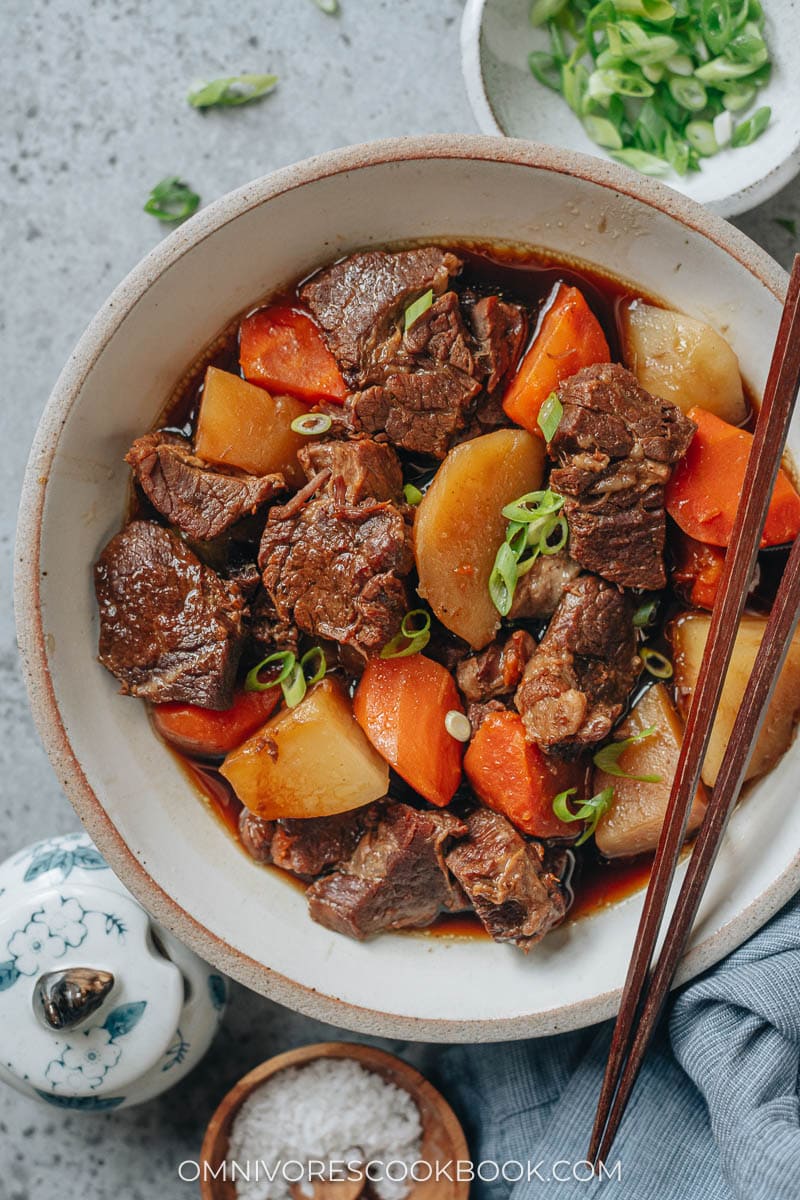
The beef is braised in a rich, savory broth with potatoes and carrots until super tender and flavorful. An easy make-ahead recipe that requires little prep, it’ll give you delicious dinners for the next couple of days. I include methods for making it in an Instant Pot or on the stovetop, so you can choose whichever works for you. {Gluten-Free Adaptable}
Chinese beef stew with potatoes and carrot is a dish I cook on repeat, especially during the colder winter months. The beef is briefly blanched to remove the impurities. It is then simmered with warm spices such as star anise and cinnamon, plus Shaoxing wine and soy sauce to create a dish full of umami. And I love the flavorful root vegetables that are braised in the beef broth, which is sometimes even more appealing to me than the beef itself.
The recipe was originally a stovetop recipe. But over the years I’ve found that the Instant Pot method is much easier and hands off. You can set it up and forget about it. And the result is just as wonderful.
I’ve included both methods, including with and without an Instant Pot, in my recipe below.
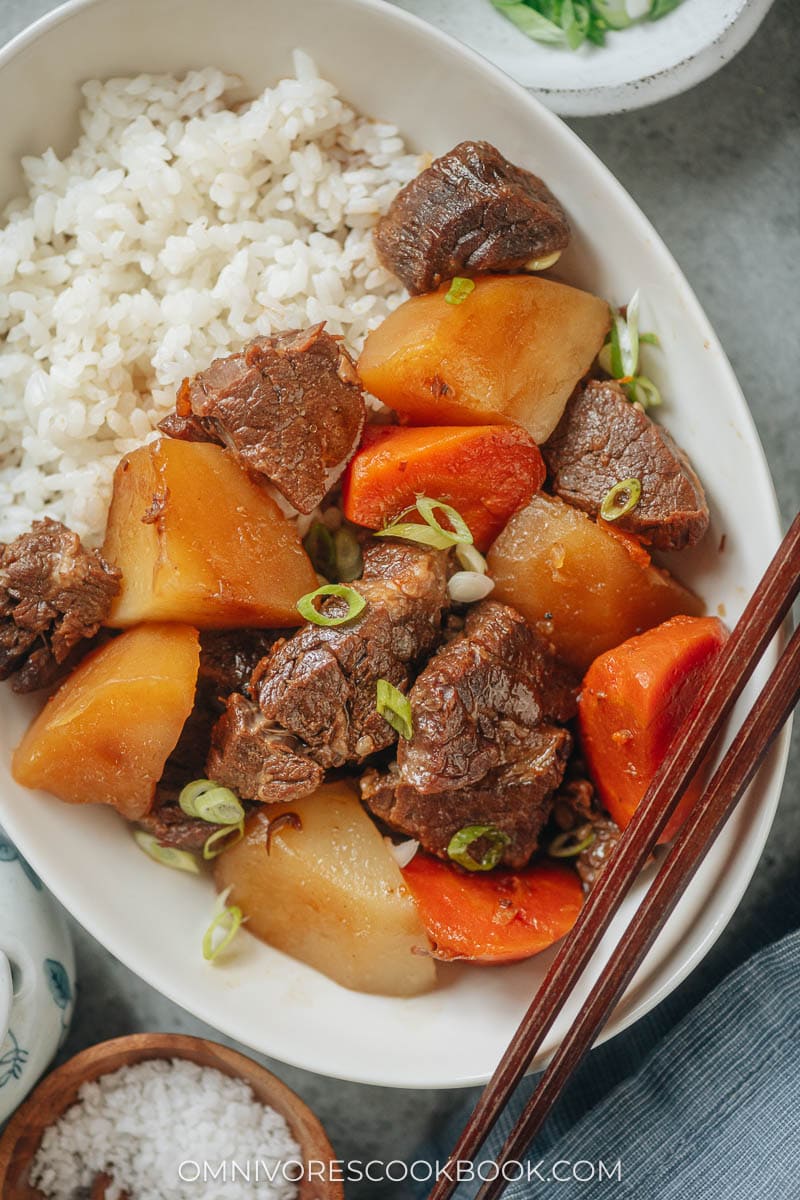
Chinese beef stew ingredients
1. What cut of beef to use
To make the best beef stew, you should use a cut that contains a good amount of fat and collagen. The fat keeps the lean part moist, and the collagen melts into a tender buttery texture once fully cooked. Both combine to create melt-in-your-mouth juicy tender chunks of beef.
A well marbled chuck roast or fatty brisket (usually called “second cut” or “deckle”) is the most affordable and convenient cut.
On the pricier end, oxtails and short ribs are excellent for beef stew. I did not include these two cuts in my recipe because they are quite expensive these days and I save them for special occasions.
Beef neck and shin bones are affordable options as well and produce excellent results. But you will get less meat, since a good third of each piece is bone weight.
Braising ingredients
The base of the braising liquid is made up of light and dark soy sauce and Shaoxing wine.
The dark soy sauce is quite important here since it gives the dish its appealing dark brown color, and it adds a hint of caramel flavor.
The green onion, ginger, bay leaves, star anise, cinnamon sticks, dried chili pepper, sugar and black pepper work together to create the ultimate umami that is warm and fragrant.
I included a mise en place picture below so you can see all the ingredients. But in reality, you do not need to portion out the ingredients into small bowls. Instead, simply add them as you cook the beef stew.
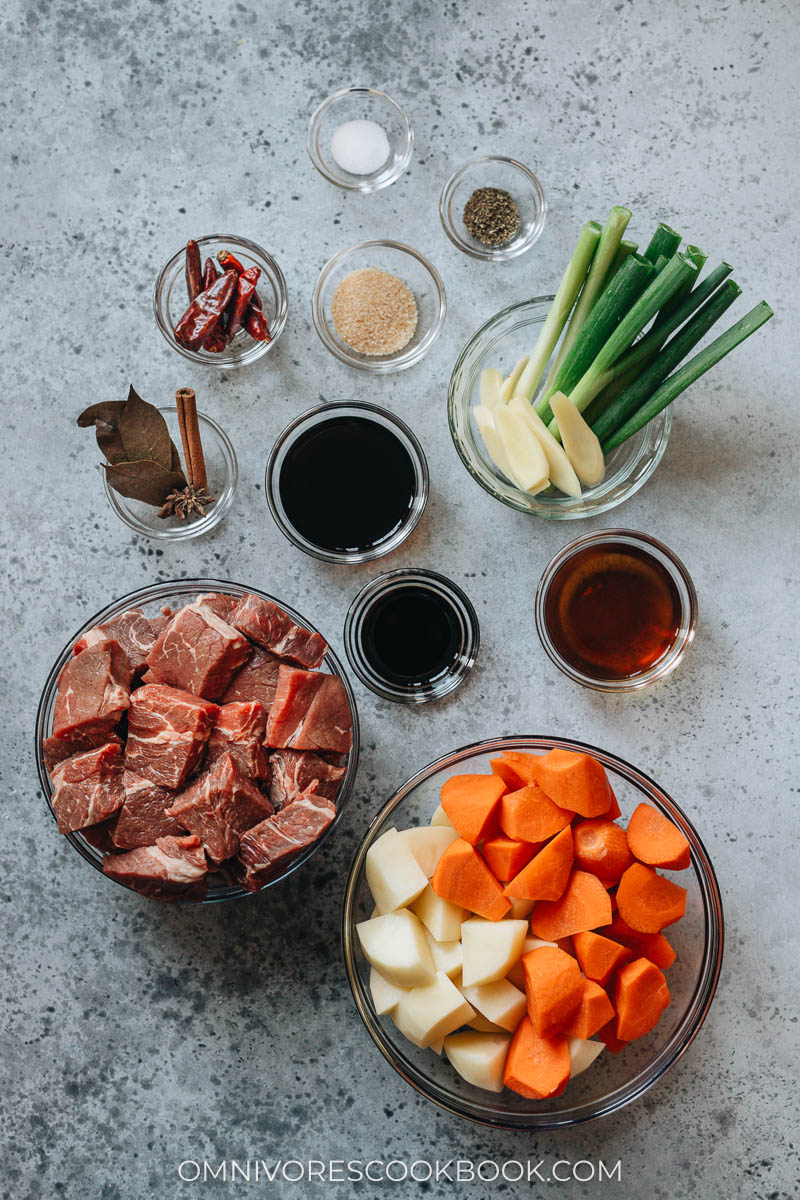
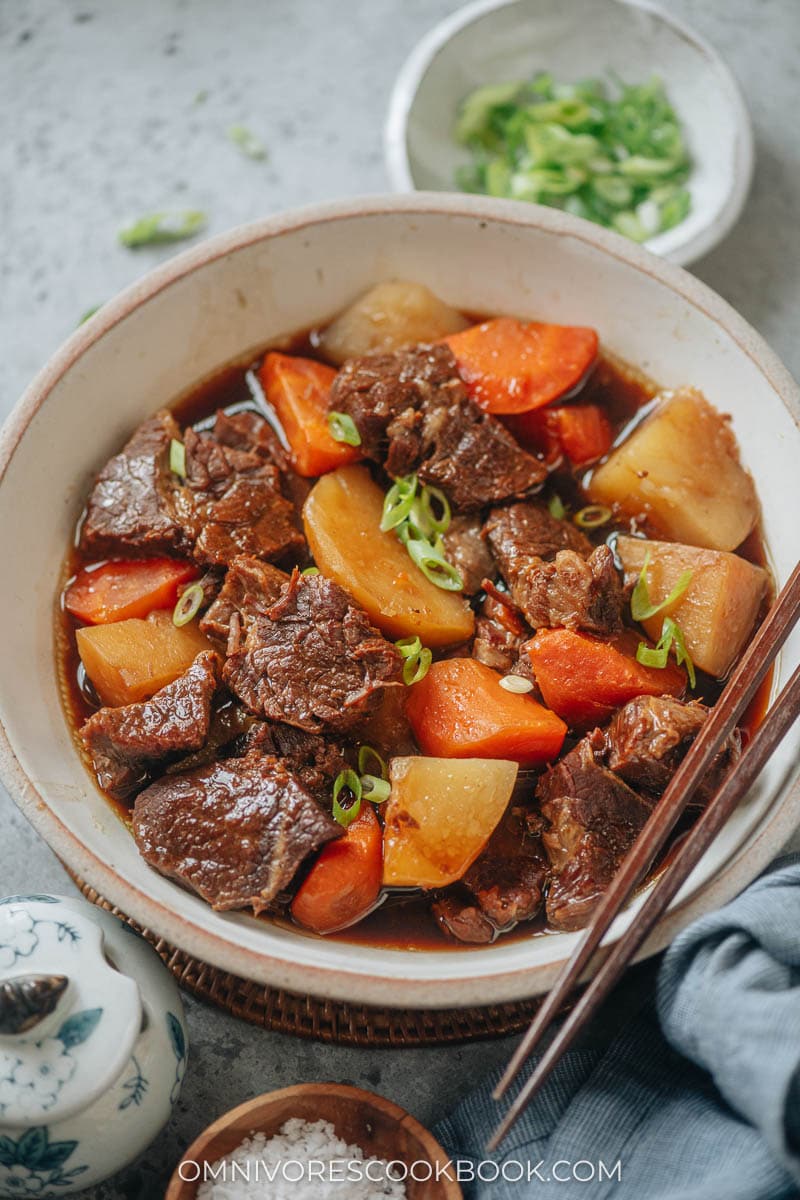
How to make Chinese beef stew
Making Chinese beef stew takes very little active time, especially if you make it in an Instant Pot:
- Cover the beef in cold water
- Boil the beef and skim the impurities
- Transfer the beef to an Instant Pot and add the liquid seasonings
- Add the rest of the spices and cook over high pressure until tender and flavorful
- Remove the spices
- Add the potato and carrot and pressure cook again until tender
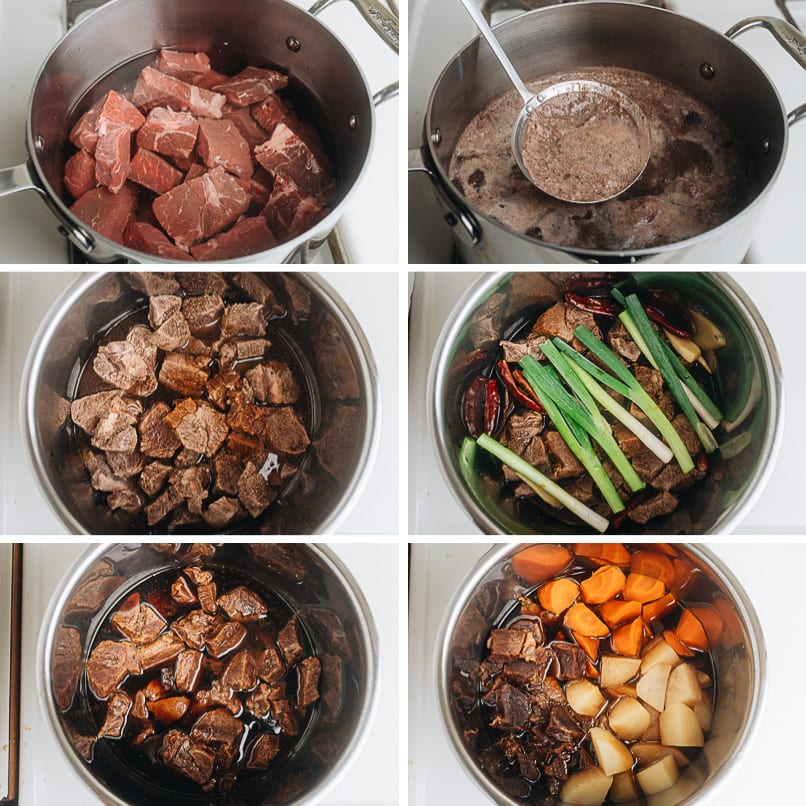
The stove top method is pretty much the same. Except that you do not need to transfer the beef once you skim off the impurities. And the braising will take longer.
How to serve beef stew
I have to admit that the Chinese beef stew tastes even better on the second day, when the root vegetables have soaked in the rich beef broth and become super flavorful. That’s why I always make a big batch, to ensure I have enough for leftovers.
You can simply serve the beef stew as a main course by itself, or over steamed rice or boiled noodles for a one-bowl meal.
I also like to make beef noodle soup by simply combining the beef stew, some water and some boiled noodles together in a bowl.
Once you finish the beef and the veggies, if you have extra sauce left, you can save it and add it to your stir fried vegetables. It is like an umami bomb that is no less flavorful than MSG.
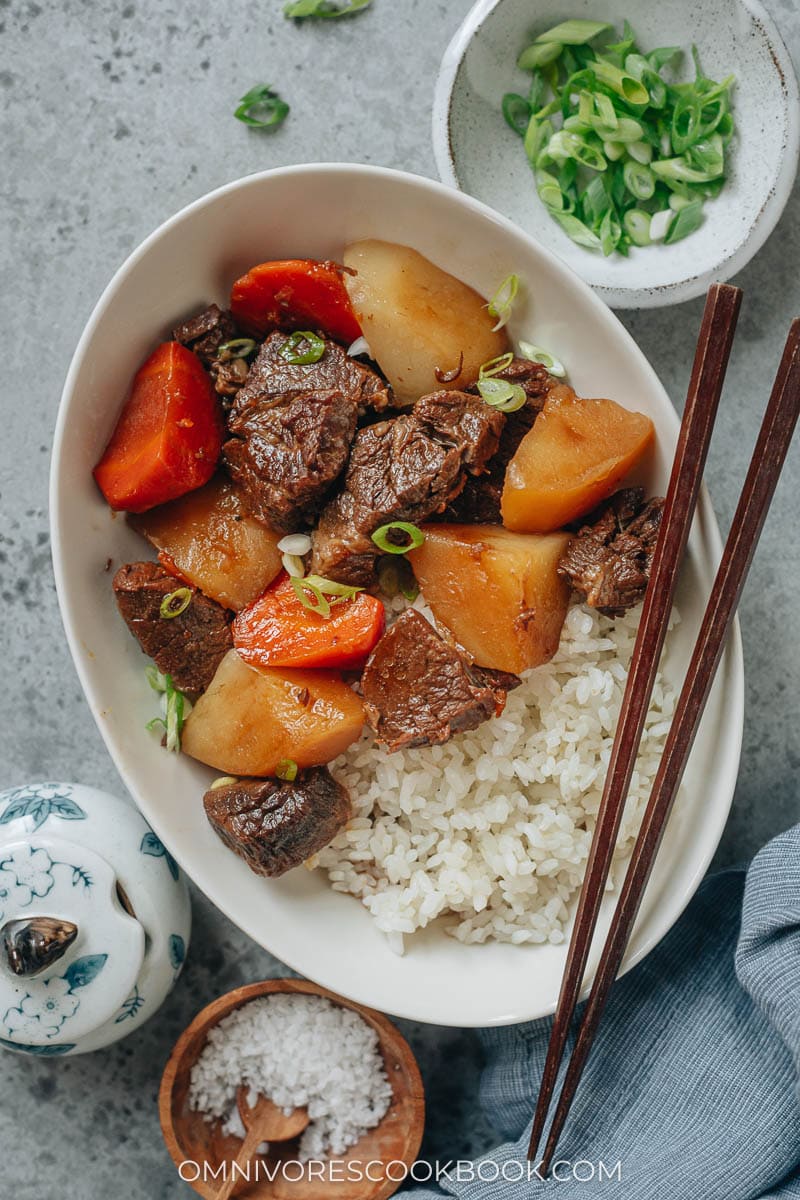
More braising recipes for bulk cooking
- Instant Pot Curry Beef Stew
- Chinese Oxtail Soup
- Chinese Braised Pork Trotters (红烧猪蹄)
- Coca-Cola Chicken Wings (可乐鸡翅)
- Korean Instant Pot Short Ribs (Galbi Jjim)
- Hong Shao Rou (Red Braised Pork, 红烧肉)
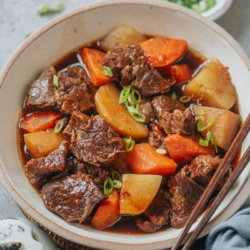
Chinese Beef Stew with Potatoes (土豆炖牛肉)
Ingredients
- 1 beef chuck roast (2 to 3 lbs / 1 to 1.3 kg) , cut into 1.5” (3 cm) chunks (or brisket, neck bone, shin bone)
- 1/4 cup Shaoxing wine
- 1/4 cup light soy sauce (or soy sauce)
- 1 tablespoon dark soy sauce
- 1 tablespoon sugar
- 1/2 teaspoon coarsely ground black pepper
- 1/2 teaspoon salt
- 6 dried chili peppers
- 1 thumb ginger , sliced
- 3 green onions , halved crosswise
- 4 bay leaves
- 1 star anise
- 1 cinnamon stick
- 2 medium waxy potatoes , cut into 2” (5 cm) pieces (or 1 large russet potato)
- 1 large carrot , cut into 2” (5 cm) pieces
Instructions
- Place the beef in a 4-qt (3.78-L) dutch oven or large pot. Add 4 cups of cold tap water so the water just covers the beef. Heat the pot over medium-high heat until it reaches a gentle boil. Stir occasionally to prevent the beef from sticking to the bottom of the pot. Turn to medium heat. Let it boil gently for 10 to 15 minutes. While boiling, skim the foam from the top of the broth and discard it until the broth is clear.
To make the dish in an Instant Pot
- Transfer the beef and 1 cup of broth from the beef boiling water to your Instant Pot.
- Add the Shaoxing wine, light soy sauce, dark soy sauce, sugar, black pepper, and salt. Stir a few times to distribute the ingredients evenly.
- Add the dried chili pepper, ginger, green onions, bay leaves, star anise and cinnamon stick. Make sure most of the dried spices are submerged in the liquid.
- Seal the Instant Pot. Set the pressure to high, and the timer for 40 minutes for chuck roast, 50 minutes for neck and shin bones, and 60 minutes for brisket.
- Once cooked, let release pressure naturally, for at least 20 minutes, before using manual release.
- Remove the green onion, ginger and spices as much as you can and discard them.
- Move the beef pieces to one side of the pot. Add the potato and carrot and submerge them in the broth as much as you can.
- Seal the Instant Pot again. Set the pressure to high and timer for 2 minutes.
- Once cooked, let release pressure naturally, for at least 20 minutes, before using manual release.
To make the dish on the stovetop
- Add the Shaoxing wine, chili peppers, ginger, green onion, bay leaves, sugar, dried chili pepper, black pepper, ginger, green onions, bay leaves, star anise and cinnamon stick (*Footnote 1). Turn to medium-low heat. Let simmer, covered, for 40 minutes for chuck roast. Simmer for 60 minutes for brisket, neck or shin bones.
- Add the light soy sauce, dark soy sauce, and salt. Stir to mix well. Continue simmering uncovered until the beef turns tender but not to the point of falling apart, about 1.5 hours for chuck roast, and 2 hours for brisket, neck or shin bones.
- Remove as much as ginger, green onion and the dried spices as possible and discard them. Add the carrots and potatoes. Simmer uncovered for another 20 to 30 minutes or so, until the veggies are tender.
Serve and store
- Serve hot as a main over steamed rice or boiled noodles. You can also use the beef stew to make noodle soup by adding more water to the broth.
- The beef stew can be stored in the fridge for 3 to 4 days, or in the freezer for up to 3 months.
Notes
- Adding salt and ingredients that contain salt will make the beef take longer to turn tender. That’s why the soy sauce and salt are added later.






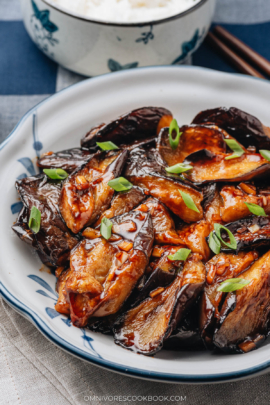






When do you add the cinnamon stick and star anise?
They are added at step 2. Just updated the recipe. Happy cooking!
Hi Maggie, Do you think this could be done in a slow cooker at all following your stages? Would you have an6 reservations on this? Thanks again for your posts…
Hi Sashi, I’m pretty sure you can! Let me know how it goes 🙂
Made the recipe and came out great. Short on sauce though. How much sauce should be left over at end of the cooking process?
This recipe is awesome, thank you Maggie! I used 1tsp Chinese 5 Spice Powder instead of star anise as I didn’t have any on hand, and my family loved the results.
What do you think of adding bok choy in to the liquid with the carrots and potatoes? I want to add some extra veggies one-pot style and feel like that would go well.
Can’t wait to try some of your other recipes! 🙂
Hi Lauren, I’m glad to hear you like the recipe! You can definitely add bok choy in the liquid. I would add them at the end of the cooking, and cook for 2 to 3 minutes until they turn tender. If there’s not enough liquid to submerge the bok choy, simply cover the pot and let them steam for a while until they are cooked through.
Hi Maggie – This recipe was amazing! I made it last night and my husband and I both LOVED it. It reminded me of the stew that my parents made growing up. Thank you so much for this website – it’s such an amazing resource for a Chinese American like me, who grew up loving these foods but who never quite learned how to cook them (or even find ingredients due to my limited Chinese). Keep doing what you do!
When do you add the salt?
Hi Dawna, sorry for the confusion! You should add the salt during the step of adding the soy sauce. I just updated the recipe so now it’s correct.
Thank you for posting this. This recipe felt closest to my mom’s recipe, and I was happy with the results. I did some things differently: substituted daikon for potatoes and rock sugar for sugar, decreased dried chili peppers (to 4), added 3 cloves, and parboiled the beef (used flank) and discarded the liquid for a cleaner broth. Having said that, I liked the kick the dried chili peppers gave, but even at 4 peppers felt that this was too spicy for me and in some ways overpowered some of the other spices. I would try to use a spice bag next time as fishing out the cinnamon, star anise, and bay leaves were a bit of a pain. I would also brown the beef and spices the next time I make this, as I think that would help develop the flavors a bit more. Even still, this was a hit. I look forward to trying it in the Instant Pot to decrease cooking time.
1. I want to use my stovetop pressure cooker (tomorrow 21st April 2020).;
2. At Step 3 cook on high.;
3. Fast depressurize.;
4. Add carrots and potatoes;
5. Pressure cook on high for 4 minutes;.
6. Fast depressurize;
7. Shouldn’t take more than 36 minutes all told.
Will serve over rice noodles.
What do you think?
Sounds pretty good to me!
Well, I did it!
I’ve stewed beef before but never have I boiled the beef as described. However, I did as instructed but had problems with the skimming. Finally, I removed the beef from the pot and used the filter from the coffee pot and got great broth. Unbelievable.
I then put everything in my trusty stovetop pressure cooker; cooked on high pressure for 20 minules; cooled the pot under the kitchen faucet; added the vegetables and cooked for a further 4 minutes on high.
I was really doubtful as the cooking proceeded, but when I tasted at the 20 minute point I was really pleased.
The beef and vegetables were transferred to a serving dish and the sauce simmered with a tablespoon of corn starch for two minutes.
I was supposed to serve the stew with rice noodles but forgot completely about them. I had some freshly cooked dasheen and green fig (for tomorrow) on hand and that topped off a Chinese/Creole lunch.
Caribbean Pot has met a worthy challenger!!!
I forgot the photograph too. Sorry!
This is a wonderful beef stew with many of our favourite Chinese flavours. Added one extra star anise and mushrooms. Will definitely make again. Thanks.
Made exactly as per your recipe.
Outstanding. Complex. The heat was just right. Chuck/ blade roast perfect for this. Perfect amount of fat.
On top of jasmine rice. Absolutely outstanding.
This is so amazing! True taste of China! My husband just loves it 😌
I make this for
My Chinese husband but add a little Chankiang vinegar too
Hi i tried the recipe but i feel that the xiaoxing wine over powered the recipe tnx is it normal ? First tyn cooking
It’s an ingredient I like to use a lot (usually pour a bit more when deglazing the pan etc). But if you think the taste is too strong, you can reduce it to 2 tablespoons next time.
Was wondering about pre-cooking the meat in our Instant Pot. We get a lot of collagen and goodies for strong and healthy joints from cooking our lamb and beef under pressure. We’ve enjoyed some of your other recipes using our Instant Pot but will follow your steps here if it’s not appropriate for this recipe
This recipe can be made in the instant pot, but the water ration will be different (I would try with 1/2 cup of water), since you will use shorter cooking time and the liquid doesn’t reduce much in the IP. I will also add the carrot and potato later, after the high pressure cooking, to prevent from overcooking. When you cook the potato and carrot, you can also use the opportunity to reduce the liquid, so the broth will thicken a bit more.
For an intant pot recipe, perhaps you’d like to try out this one: https://omnivorescookbook.com/instant-pot-braised-beef/
This one is great as well: https://omnivorescookbook.com/pressure-cooker-curry-beef-stew/
I love this recipe! It smells wonderful while simmering and tastes delicious!
I love this recipe! Smells delicious while simmering and tastes delicious! (Forgot to rate it before I submitted, so here is my review again)
Hi, may I know what’s the substitute for shaoxing wine as I don’t have it😁
If you have another type of alcohol such as Japanese sake or beer, that would be the best replacement. If you don’t have it or prefer not to use any alcohol at all, I would just skip it.
Love your recipes (I make at least one once a week) but I think the total time on this one might need to be updated? Even in the Instapot, the time listed doesn’t seem correct? (It’s 40 minutes in the pot and not 30.) And it looks like the option with the Instapot takes even longer. Got blindsided by this on a weekday when I didn’t read ahead! (Which is my bad, but still!) Thanks a ton for sharing and being awesome!
Thanks for bringing this issue to my attention. I have a field for “inactive cooking time” in my recipe card, where I use it to fill out time such as adding / release pressure for IP. But I just realized that the recipe card does not show this information on my blog.
I have updated the recipe card to at least show the proper 40 mins IP cooking time. I cannot see an option to show the field “inactive cooking time” and I will look into it.
So sorry about the confusion!
Love this recipe, made it a couple times now! I made it with brisket on the stovetop and the cooking times worked great, the only problem is there wasn’t nearly enough liquid left after simmering. Makes sense and maybe obvious to others but if you’re using tougher meat add a couple cups of water while cooking (so far I’ve forgotten every time but next time I won’t haha).
I’ve been making this for awhile and I made it for church potluck… Everyone complimented it! Even said it tasted like the restaurant! Mind you, these are old Taiwanese ppl so you know it’s a great compliment!
Hi Maggie, I’m cooking this on the stovetop. Your instructions say to let it simmer uncovered for 1.5 hours. How do you keep the water from boiling off? There will not be enough water at the end to cook the potatoes. Thanks.
I remember when I cooked the stovetop version (that was long time ago), I did use a very low heat for simmering (not like the low boil I use for braising meat in a wok). By the time to add potato, the liquid didn’t reduce that much (the liquid can still cover most of the beef pieces). There wasn’t enough to liquid to fully cover the potatoes, but I managed to flip the meat to let the potato sit more in the liquid for the cooking. The purpose of uncovering the pan was because I want the broth to reduce naturally, so you end up with a more flavorful broth.
Now that I think about it, I think it’s best to cover the pot when you simmer the beef for 1.5 the hours, just to make sure the broth doesn’t run dry. You can always turn up the heat to reduce the broth later if needed. At the end of the cooking, if everything was cooked and done, and the broth is too thin, you can always transfer all the meat and potatoes into a big bowl, and reduce the sauce in the pot (it usually takes 15 minutes or so, with medium high heat).